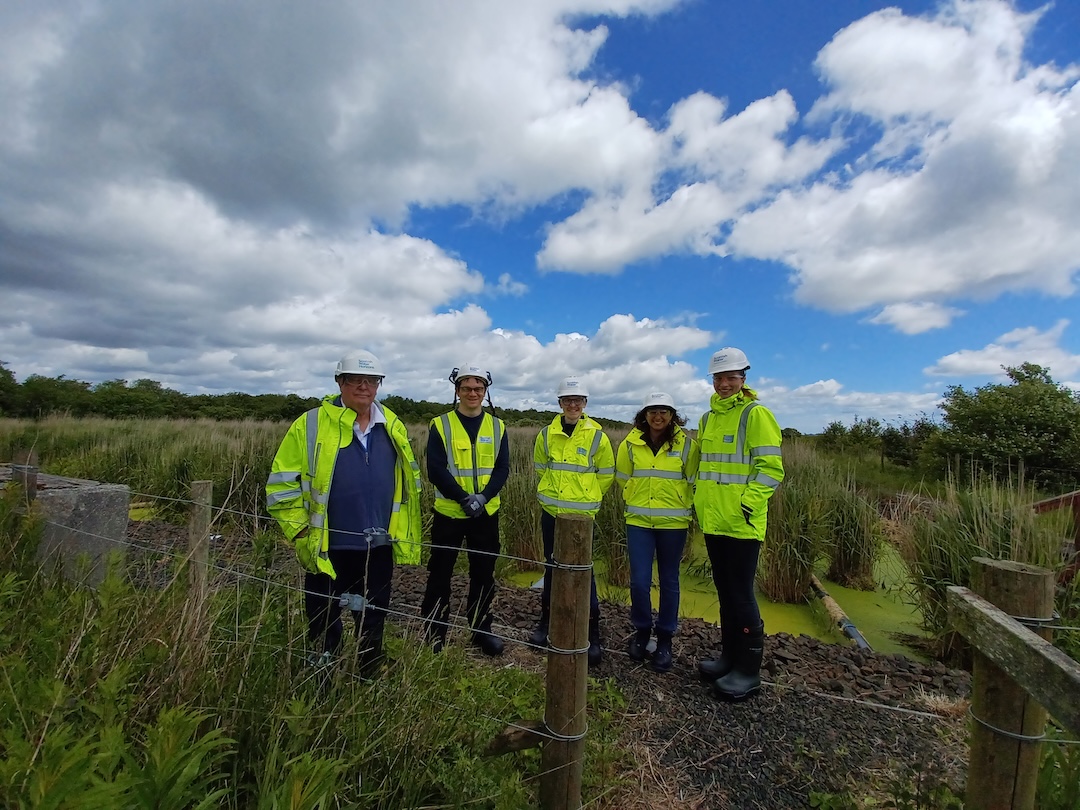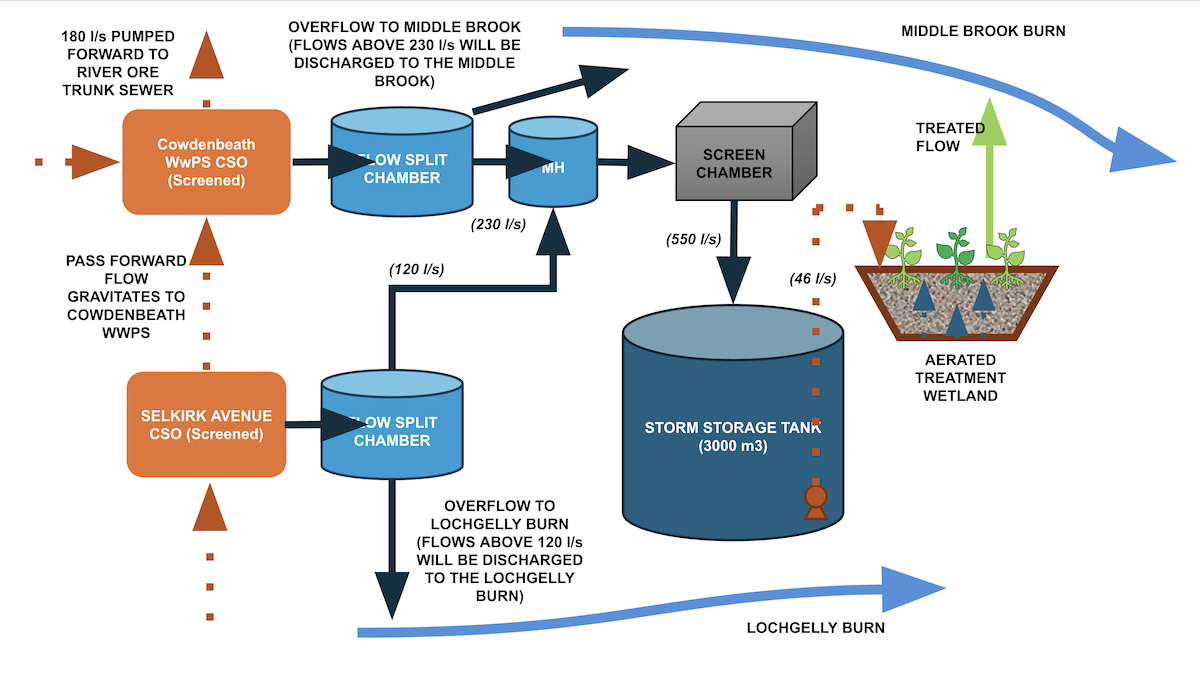
Scottish Water operates under Strategic Review 27 (SR27), which sets the framework for how Scottish Water will address key challenges, including climate resilience, infrastructure upgrades, and environmental sustainability for the 2027-2033 period. As part of this, Scottish Water is aligning its approach with AMP8 priorities, including Nature-based Solutions (NbS) and Biodiversity Net Gain (BNG), to enhance water management while supporting Net Zero goals. This strategic direction ensures that investments in eco-friendly alternatives contribute to long-term environmental and operational benefits.
Scottish Water’s Hierarchy of Nature-based Solutions
Nature-based solutions (NbS), as defined by the International Union for Conservation of Nature in 2016, are, “Actions to protect, sustainably use, manage and restore natural or modified ecosystems, which address societal challenges, effectively and adaptively, providing human well-being and biodiversity benefits.” Scottish Water’s hierarchy of NbS provides a structured framework for classifying and understanding various NbS terms to standardise complex terminologies and classifications.

Figure 1. Scottish Water's Hierarchy of Nature-based Solutions
Blue-green Infrastructure
Blue-green infrastructure (BGI) integrates natural elements in urban areas. Traditional urban drainage systems reduce soft ground and increase impermeable paving, which could lead to flooding and water pollution. Sustainable Urban Drainage Systems (SuDS) mimic natural drainage processes to mitigate the impact of urbanisation on the hydrological cycle while making space for nature and increasing biodiversity.
Substrate-based Systems
Natural, modified, or constructed waterbodies use natural processes to break down organic matter, remove pollutants and improve water quality while restoring important habitats for 40% of the earth’s plants and animals.
Hybrid-based Technologies
Hybrid-based technologies combine natural and engineered processes to optimise wastewater treatment and create multi-stage wastewater purification systems that break down sludge and remove greenhouse gases to clean water before it is returned to water sources.
Cowdenbeath CSO Wetland: A Harmony of Engineering and Ecology
Situated in West Fife, Scotland, the Cowdenbeath Combined Sewer Overflow (CSO) Wetland stands as a pioneering solution, blending modern wastewater treatment with natural ecosystem processes. This innovative facility, a collaboration between Scottish Water, Atkins, and ARM Reed Beds, was developed to address chronic water quality issues in the Lochgelly Burn, a watercourse previously classified as severely polluted. By integrating engineered treatment systems with natural ecological processes, the wetland provides a sustainable and effective means of treating stormwater overflows before they return to the environment.
The Ecological Engine
Cowdenbeath CSO Wetland is a Forced Bed Aeration™ (FBA™) reed bed, a specialised system designed to enhance ecological wastewater treatment. Unlike traditional passive wetlands, FBA™ systems actively increase oxygen levels in the treatment medium, accelerating microbial processes that break down contaminants (ARM Reed Beds, n.d.).

Figure 2. Forced Bed Aeration ™ (ARM Reed Beds, n.d.)
Microbial Breakdown and Plant Filtration
The Cowdenbeath CSO Wetland relies on a combination of microbial and plant-based processes to treat wastewater effectively. Nitrifying bacteria colonise the submerged gravel bed, breaking down organic pollutants such as biochemical oxygen demand (BOD) and ammonia. The reed bed filtration system enhances treatment by physically filtering sediments, uptaking nutrients, and oxygenating the microbial biofilm to further accelerate pollutant degradation. Additionally, the wetland promotes nutrient cycling, converting nitrogen and phosphorus compounds into less harmful forms, thereby preventing eutrophication in downstream water bodies.
Ecological Benefits
The wetland supports biodiversity by creating a habitat for aquatic and terrestrial species. Birds, insects, and amphibians are able to benefit from the wetland, transforming a former industrial site into an ecological haven.
The Mechanical Backbone
While the wetland's ecological functions are essential, the underlying mechanical infrastructure ensures the system operates efficiently. The hydraulic control and aeration mechanisms work in tandem to regulate flows and maintain optimal treatment conditions.
Crucial Engineering Features:
Storage and Flow Regulation
- A 3,000m³ underground storage tank captures and regulates excess flows during storm events.
- A pumping station and valve chamber ensure controlled delivery of wastewater to the wetland, preventing hydraulic overloads.
- The flow control system diverts up to 350 litres per second, ensuring efficient processing without overwhelming the reed bed.
Forced Bed Aeration™ (FBA™) System
- The aeration network, consisting of perforated pipes laid beneath the gravel, delivers oxygen-rich air to the microbial biofilm.
- Air is supplied by external blower units, which operate intermittently to maintain aerobic conditions, preventing stagnation and odour buildup.
- This system significantly enhances pollutant breakdown, making the wetland up to 15 times more effective than conventional passive reed beds.
Treatment and Discharge
- Once treated, the purified water is discharged through a gravity-fed outlet system into the Middle Brook Burn, upstream of the Lochgelly Burn, meeting stringent regulatory standards set by SEPA (Scottish Environmental Protection Agency).
- The system is designed to meet final effluent targets of BOD (9.0 mg/L) and ammonia (1.5 mg/L), demonstrating high treatment efficiency.

Figure 3. Revised Schematic for Cowdenbeath WwWP CSO
Regulatory Compliance
The site has consistently complied with environmental standards from 2014 to 2019, as assessed by the Scottish Environment Protection Agency (SEPA), reflecting its robust design and operational effectiveness.
Scottish Water plans to enhance the monitoring capabilities of the Cowdenbeath CSO Wetland by installing advanced effluent monitoring equipment in 2025, which provides real-time data on effluent parameters, enabling a more precise assessment of the wetland's performance and ensuring compliance with environmental standards.
A Sustainable Future for Wastewater Treatment
The Cowdenbeath CSO Wetland represents a paradigm shift in urban wastewater management, proving that infrastructure can be functional and environmentally regenerative. By merging ecological treatment with mechanical precision, the facility provides a cost-effective, low-energy solution to stormwater pollution while enhancing local biodiversity. Solutions like Cowdenbeath’s wetland will become essential blueprints for sustainable water management worldwide. Nature and engineering, working in harmony—this is the future of wastewater treatment.
“The success of the Cowdenbeath CSO Wetland has demonstrated the power of nature-based solutions in wastewater treatment. By integrating ecological engineering with mechanical engineering, we’ve improved water quality while enhancing sustainability. Scottish Water is exploring how this approach can replace conventional technologies in future projects. With new monitoring equipment set to capture real-time effluent data in 2025, we’ll reinforce the effectiveness of this solution, helping shape investment decisions for SR27 and beyond.” - Alexandra Combes, Nature-based Solutions Technologist, Scottish Water
The Pump Centre is proud support members like Scottish Water in their mission to develop innovative nature-based solutions within the water industry and provide solutions to the challenges of AMP8.
